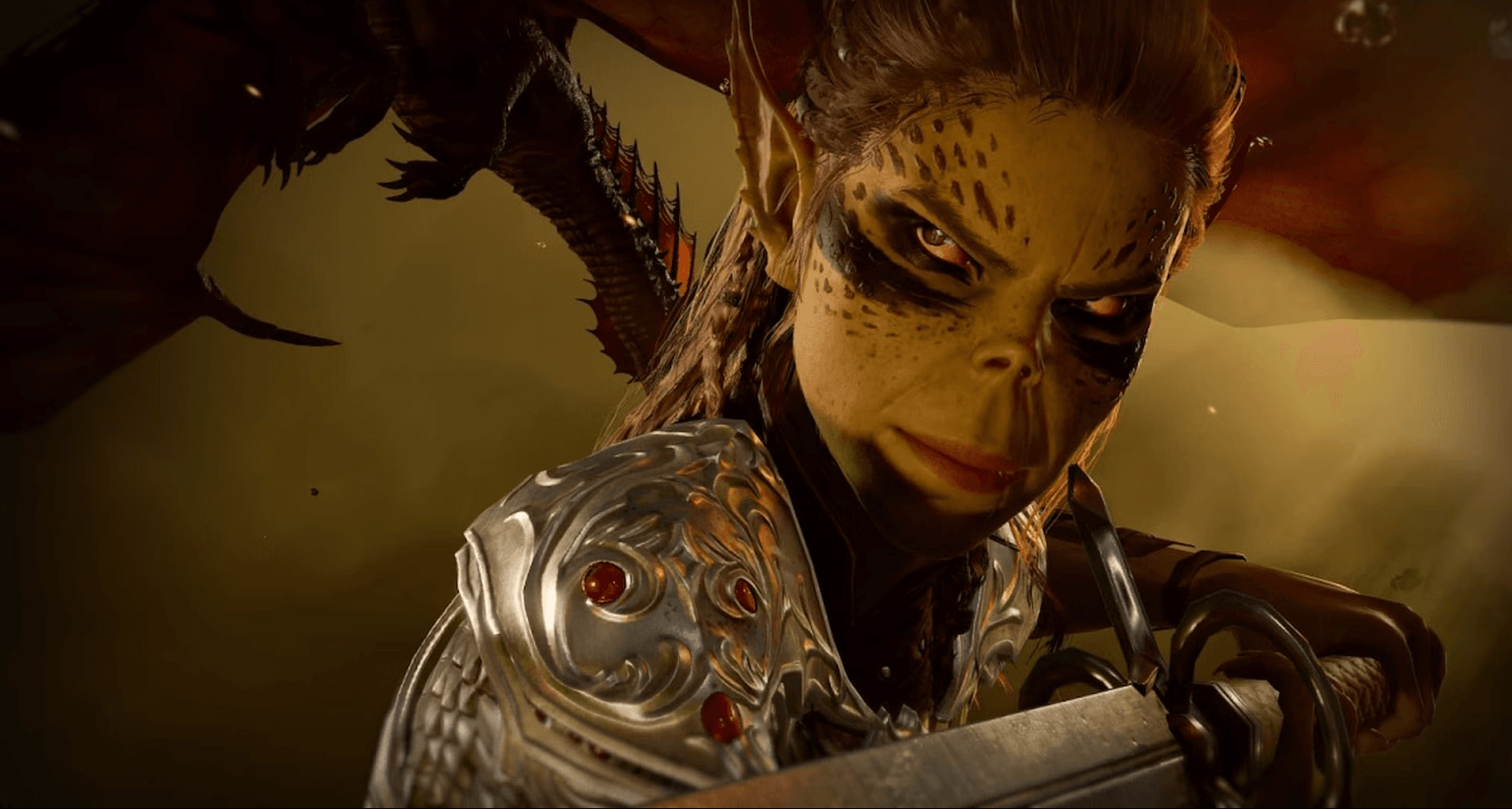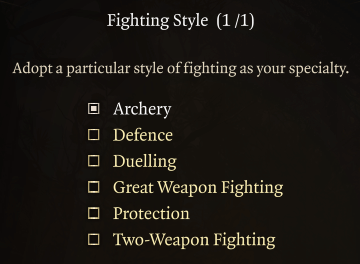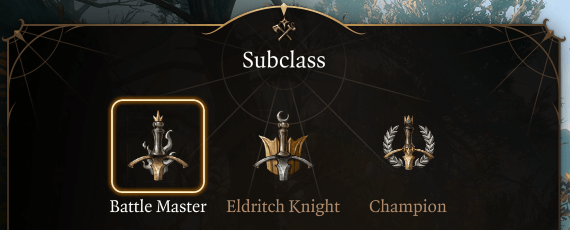Everything You Should Know About the Baldur’s Gate 3 Fighter and its Subclasses
Tenacious, furious and dangerous, the Baldur’s Gate 3 Fighter is a master of the art of combat.
All Fighters mainly focus on building their physique, which leaves them relying on their Strength and Constitution to get them through battle.
Some Fighters even study the Arcane, and become Eldritch Knights to supplement their physical strength with additional magical capabilities.
Other Fighters focus on tactical prowess, becoming true Battle Masters.
The remaining Fighters have no other care than to purely strengthen their bodies, with the only goal in mind becoming hard-hitting Champions.
Overall, BG3 Fighters make the most out of their weapons and armor, being able to select a particular Fighting Style that best suits the type of play you want to do.
![]()
This, coupled with the three Subclasses also gives Fighters a unique flexibility in being able to choose if they prefer being a strict tank, or gear themselves more towards a ‘bruiser’ role.
In this guide, we will cover all the Fighting Styles as well as every Subclass, and how each one would fit into particular playstyles and party roles. Follow this guide, and your Fighter may even match the ferocity of Lae’zel herself!
Find out where the Fighter ranks in our Baldur’s Gate 3 class tier list.
Pros and Cons
Pros
- Gain the ability to dish out multiple heavy hits of damage in one turn with bursts of attacks using the Action Surge and Extra Attack features.
- Very flexible when it comes to the weapons they use, this allows them to fit many playstyles and team compositions that you may want to do.
- Excel at prolonged encounters, especially Battle Masters, as their Superiority Dice can refresh after every Short Rest. This, coupled with how naturally tanky the class is, as well as the ability to heal themselves with Second Wind, allows for Fighters to remain active for prolonged and repeated encounters.
Cons
- Lacks mobility when compared to many other melee classes, such as Monk or Rogue. Fighters have very little natural capabilities to help close the gap, and may have to rely on Feats such as Charger to get in close.
- While Fighters excel at 1-on-1 combat, they lack in Area of Effect and ranged options compared to some other classes, unless you spec your Fighter completely to become an Archer through the Archery Fighting Style.
- Fighters do not typically make for being a good “people-person”, due to the lower scores in CHA compared to Paladin or Sorcerer. This can lead to requiring someone else to become the effective “face” of the party

Fighter Mechanics and Roleplay
Battle-hardened and fierce, the Fighter imposes a command of authority over those whom they come across. Spending years honing their bodies through rigorous martial training and years more bettering themselves in trials of combat – the Fighter is a calculated force to be reckoned with.
Fighters are not bound to any Oath like Paladins, nor have they forged a contract for their strength like a Warlock. Instead, players are given a unique freedom to take the Fighter class to any roleplaying extent they wish.
From mercenary to outcast, the Fighter has – for one reason or another – had to make the decision to live a life of combat.
They allow their weapons to do the talking, caring not for frivolous conversations that do not lend any benefit to them. From tribal warrior to a noble guard, the Fighter has picked up their blade for one purpose – to defend those they love.
Fighting Styles

At the beginning of every Fighter’s journey, you will adopt a Fighting Style that best suits how you want to play and fit into your party.
Fighters select one Fighting Style to specialize in from Level 1, with the Champion subclass giving the option to master the art of two Fighting Styles at Level 10.
Fighting Styles are also available to Paladins, Rangers, and Bards (College of Swords subclass only), but Fighters have the most options of all Classes to select from.
| Fighting Style | Description |
|---|---|
| Archery | You gain a +2 bonus to attack rolls you make with ranged weapons. |
| Defense | While you are wearing armor, you gain a +1 bonus to AC. |
| Dueling | When you are wielding a melee weapon in one hand and no other weapons, you gain a +2 bonus to damage rolls with that weapon. |
| Great Weapon Fighting | When you roll a 1 or 2 on a damage die for an attack you make with a melee weapon that you are wielding with two hands, you can reroll the die and must use the new roll, even if the new roll is a 1 or a 2. The weapon must have the two-handed or versatile property for you to gain this benefit. |
| Protection | When a creature you can see attacks a target other than you that is within 5 feet of you, you can use your reaction to impose disadvantage on the attack roll. You must be wielding a shield. |
| Two-Weapon Fighting | When you engage in two-weapon fighting, you can add your ability modifier to the damage of the second attack. |
Features
From level 1, Fighters gain proficiency with Simple Weapons, Martial Weapons, Light Armor, Medium Armor, Heavy Armor and Shields. In addition, Fighters also gain a few notable Features to bolster their martial prowess:
| Level | Feature | Description |
|---|---|---|
| 1 | Second Wind | Heal for 1d10 + Fighter Level hit points |
| 2 | Action Surge | Immediately gain an extra action to use this turn. |
| 5 | Extra Attack | Can make an additional free attack after making an unarmed or weapon attack. |
| 9 | Indomitable | You have become as durable as an iron golem. Whenever you fail a Saving Throw, you can roll again, using the new result instead. |
| 11 | Improved Extra Attack | You can make two additional attacks after attacking with your main-hand weapon. |
Fighter Subclasses

There are three Fighter subclasses in Baldur’s Gate 3. Each subclass focuses on how the Fighter wants to approach each battle.
The Battle Master studies a variety of combat Maneuvers to gain a tactical advantage on the field. The Champion is focused solely on strengthening their body, giving them the ability to score Critical Hits more often and adopt a second Fighting Style. The Eldritch Knight prefers learning spells to add more arcane utility into their kit.
Battle Master
| Level | Feature | Description |
|---|---|---|
| 3 | Superiority Dice: 4 | Your Superiority Dice are d8s. You have 4. At Fighter level 10, these dice become d10s. They fuel your Battle Master maneuvers and are expended upon use. You regain expended Superiority Dice after a Short or Long Rest. |
| 3 | Maneuvers | Choose 3 Maneuvers. Maneuvers are powerful attacks that use superiority dice. |
| 7 | Superiority Dice: 1 | Gain 1 Superiority Dice |
| 7 | Maneuvers | Choose 2 Maneuvers |
| 10 | Improved Combat Superiority | The size of your Superiority Dice increases to 1d10 |
| 11 | Maneuvers | Choose 2 Maneuvers |
Battle Masters are paragons of tactical superiority, combining combat maneuvers and experience in the field to dominate every fight.
They learn Maneuvers to excel in combat, giving themselves extra capabilities with their weapons such as Disarming Strike, to physically compel the target to drop their weapon or Trip Attack that may leave the target prone.
Battle Masters excel at extended combat, as well as repetitive combat since they are able to regain their Superiority Dice (the resource that powers Maneuvers upon a Short Rest.
The subclass is often paired with the Martial Adept Feature that will grant them an additional two Maneuvers and an extra Superiority Dice to use.
Here’s a list of all the Battle Master Maneuvers:
| Maneuver | Description |
|---|---|
| Commander’s Strike | Spend an action and a reaction to direct an ally to strike a foe. The ally immediately uses their reaction to make a weapon attack. |
| Disarming Attack | Spend a superiority die to make an attack that deals an additional Ids damage and possibly forces the target to drop the weapons they are holding. |
| Distracting Strike | Distract your target, giving your allies Advantage on their next Attack Roll against the target. |
| Evasive Footwork | You can evade attacks by imposing Disadvantage on melee attacks against you for a round. |
| Feinting Attack | You can use both your action and bonus action on a turn to attack a target with Advantage and deal an additional 1d8 damage. |
| Goading Attack | Deal an additional 1d8 and attempt to goad the target into attacking you. Target receives Disadvantage on attacking any other creature. |
| Maneuvering Attack | Spend a superiority die to make an attack that deals an additional 1d8 damage. On hit, select which friendly creature will gain half its movement speed. It will not provoke attacks of opportunity. |
| Menacing Attack | Spend a superiority die to make an attack that deals an additional 1d8 damage and possibly Frightens the target. |
| Precision Attack | You can spend a Superiority Die to add it to the result of an Attack Roll. |
| Pushing Attack | Spend a superiority die to make an attack that deals an additional 1d8 damage and possibly pushes the target back 4.5m. |
| Rally | Expend a superiority die to grant an ally 8 temporary hit points, bolstering their resolve |
| Riposte | When a hostile creature misses you with a melee attack, expend a superiority die to retaliate with a powerful strike that deals an additional 1d8 damage. |
| Sweeping Attack | Swing your weapon in a rapid, sweeping arc to attack multiple enemies at once. Roll your superiority die for damage. |
| Trip Attack | Spend a superiority die to make an attack that deals an additional 1d8 damage and possibly knocks the target Prone. The target must be Large or smaller. |
Champion
| Level | Feature | Description |
|---|---|---|
| 3 | Improved Critical Hit | The number you need to roll a Critical Hit while attacking is reduced by 1. This effect can stack. |
| 7 | Remarkable Athlete: Proficiency | You’re a master of your own body, your athletic prowess extended beyond the usual. You can add half of your Proficiency Bonus to any Strength, Dexterity, and Constitution Checks that you are not Proficient in. |
| 7 | Remarkable Athlete: Jump | You’re a master of your own body, your athletic prowess extended beyond her usual. Your Jump distance is increased by 3m. |
| 10 | Pick another Fighting Style | You may select a second Fighting Style. |
Champions approach the complex problems posed by combat with one distinctly effective solution – you hit those problems, really quite hard.
The subclass excels at one thing: physical dominance. So much have they trained their bodies, that they can not only score critical hits at 19 (or lower, should other effects stack with it), but they also can increase their jumping distance and proficiency with STR, DEX and CON checks.
Champion Fighters are compared often to the Barbarian, and where the Fighters shine is in consistency. Where the Barbarian relies on upkeeping Rage for maximum effectiveness, Champion Fighters are able to consistently pump out damage and retain their base class ability to wear Heavy Armor.
Lastly, the Champion is often paired with the Great Weapon Master Feature, which allows them an extra melee attack as a bonus action when a Critical Hit is scored.
Eldritch Knight
| Level | Feature | Description |
|---|---|---|
| 3 | Spellcasting | Allows the Eldritch Fighter to learn Spells and Cantrips |
| 7 | Weapon Bond | Ritually bind the weapon in your main hand. The weapon can’t be knocked out of your hand, and it automatically returns to you when Thrown. |
| 7 | War Magic | You have honed your body and magic for war. After you cast a Cantrip, you can make a weapon attack using a bonus action. |
| 10 | Eldritch Strike | When you hit a creature with a weapon attack, it has Disadvantage on its next Saving Throw against a spell you cast before the end of your next turn. |
Eldritch Knights study magic to supplement their weaponry, allowing them to overcome resistance from the toughest foes.
The subclass perfect for those who wish to delve into magic while still being a robust frontline threat. This type of Fighter learns spells and cantrips to add utility to their arsenal, while still remaining in touch with the Fighting Style they selected. This effect can lead players to become a ‘spellblade’ type class, especially when learning the War Magic Feature, giving the ability to strike with a melee weapon after casting a Cantrip.
Here’s a breakdown of how Eldritch Knights progresses in their spellcasting (note that they unlock Wizard spells):
| Fighter Level | Cantrips | 1st Lvl Spells | 2nd Lvl Spells |
|---|---|---|---|
| 3 | 2 | 2 | – |
| 4 | 2 | 3 | – |
| 5 | 2 | 3 | – |
| 6 | 2 | 3 | – |
| 7 | 2 | 4 | 2 |
| 8 | 2 | 4 | 2 |
| 9 | 2 | 4 | 2 |
| 10 | 3 | 4 | 3 |
| 11 | 3 | 4 | 3 |
| 12 | 3 | 4 | 3 |
So which Baldur’s Gate 3 Fighter subclass should you play?
Battle Masters excel at bringing more options to the table; their maneuvers giving them an abundance of effects from crowd control to increased Attack Roll accuracy. Players should opt for Battle Master if they want a more tank-focused role that gets in enemies faces to bring them down.
Players should opt for the Champion subclass if their focus is scoring multiple Critical Hits and improving their Proficiency checks, as well as being able to select a second Fighting Style to diversify their gameplay. The Champion is a perfect subclass for beginners who still want a very effective character to play.
Taking a few pages out of the Wizards’ and Warlocks’ books; the Eldritch Knight is perfect for those who want to gear their Fighter towards the arcane while still being formidable in battle even when your Spell Slots are depleted.
Thanks for reading! As always, please remember that you can easily respec your character any time for just 100g at Withers, so feel free to try out every Fighter subclass and see which works best for you and your party!
 Download APP
Download APP